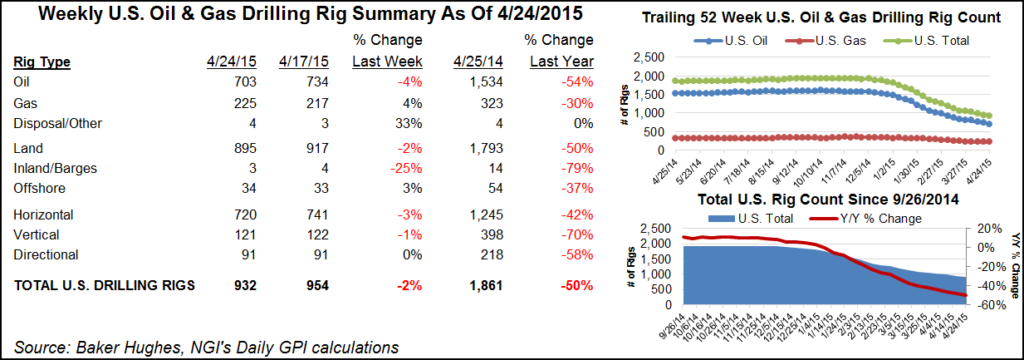NGI The Weekly Gas Market Report | E&P | NGI All News Access
NatGas Rigs Left Behind in Weekly Rig Rally
Three rigs came back to the Barnett Shale, and the Haynesville held steady at 16. But it was still lights out in the Fayetteville Shale as one natural gas rig left action for the week ending July 22. There are rigs coming back, but their operators have oil on the brain.

The Permian Basin helped power a whopping 15-rig comeback in Texas during the week ending July 22, according to the latest Baker Hughes Inc. (BHI) rig count. Also from this week onward, NGI’s Shale Daily is reporting more detailed numbers for the Permian as well as the Cana Woodford as these plays could have much to gain in the months ahead.
The Permian added eight rigs to climb to 168 running, while the rig count for all of Texas rose to 217 from 202 the previous week. There’s no denying that the rig comeback is under way, at least for oil-directed gear.

Eighteen U.S. land-based rigs returned to play while three left the offshore. Fourteen oil rigs came back while one natural gas rig left. Two “miscellaneous” rigs also returned. Horizontal units were walking tall, with 13 marching back to the patch. The directional and vertical categories added one each. The United States ended the week with a net gain of 15 to rest at 462.
Canada saw four oil and three natural gas rigs return to bring the Canadian count to 102. Overall, North America added 22 rigs for the week to end at 564.

Starting this week, NGI’s Shale Daily is parsing the Permian and separating the peanut butter from the chocolate in the Cana Woodford; that is to say, reporting separate rig counts for the South-Central Oklahoma Oil Province (SCOOP) and the Sooner Trend of the Anadarko Basin (Canadian and Kingfisher counties) (STACK).
Breaking down the latest Permian tally, there were 75 rigs running in the Delaware Basin, up five from the previous week. The Midland Basin gained three units to end at 92. That left one rig in the rest of the Permian, the same as the previous week.
Earlier in the week, Pioneer Natural Resources Inc. CEO Scott Sheffield had nothing but praise for the play (see Shale Daily, July 20). “The Permian is the mother lode. You factor in 4,000 feet of shales with 12 to 14 zones to play with…We’ll be drilling that for the next 100, 150 years,” he told an audience at an event hosted by the Center for Strategic and International Studies in Washington, DC.
And in the Cana Woodford, the SCOOP held steady at nine units, the same as last week, while the STACK dropped one rig to end at 19. And there were no rigs running in the rest of the Cana Woodford, according to an analysis of the BHI data.
But speaking of the Permian, in a note distributed on Thursday, BTU Analytics’ James Blaney — a summer analyst on the cusp of a bachelor’s degree in petroleum engineering from the Colorado School of Mines, just in time for the recovery — did some Permian math.
“With today’s drilling and completion (D&C) costs, $100/bbl prices would allow a horizontal Wolfcamp well to reach discounted payback in just under six months (IRR of 1,058%),” wrote Blaney, who, by the way, has a bachelor’s in biology and economics to fall back on. “With prices at $25/bbl, wells would not reach discounted payback for 11.5 years (IRR of 3.57%).
“In a price range more relevant to today, discounted payback can be achieved in 21 months with prices at $40/bbl (IRR of 51.4%), 12 months at $50/bbl (IRR of 109.4%), and nine months at $60/bbl (IRR of 195.1%). Despite the recent, tentative increase in drilling activity, there continue to be risks to returning to the field.”
© 2024 Natural Gas Intelligence. All rights reserved.
ISSN © 1532-1231 | ISSN © 2577-9877 | ISSN © 1532-1266 |
